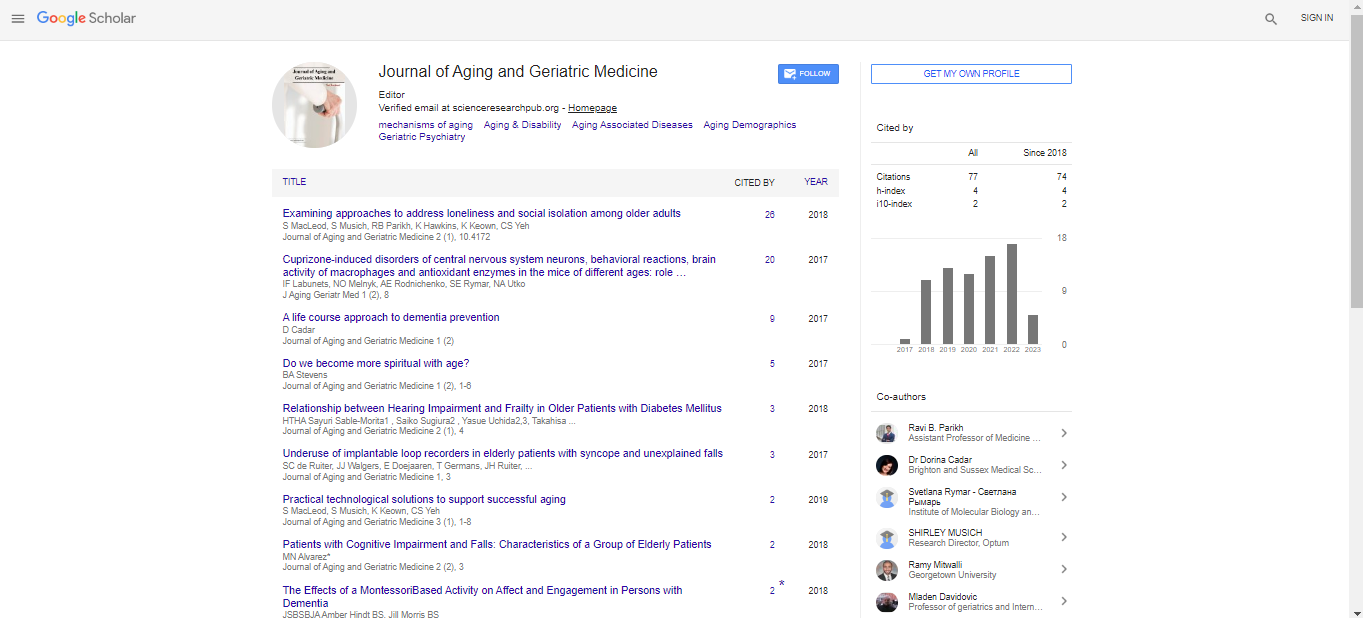Commentary, J Aging Geriatr Med Vol: 8 Issue: 1
Obesity and Therapeutics: Chronic Health Complications
Mayvhin Mark*
Department of Obstetrics and Gynaecology, University of Alabama, Alabama, USA
- *Corresponding Author:
- Mayvhin Mark
Department of Obstetrics and Gynaecology,
University of Alabama,
Alabama,
USA
E-mail: mayvhin_mark@gmail.com
Received date: 04 November, 2023, Manuscript No. AGM-23-119222;
Editor assigned date: 07 November, 2023, PreQC No. AGM-23-119222 (PQ);
Reviewed date: 21 November, 2023, QC No. AGM-23-119222;
Revised date: 15 August, 2024, Manuscript No. AGM-23-119222 (R);
Published date: 22 August, 2024, DOI: 10.4172/2576-3946.1000188
Citation: Mark M (2024) Obesity and Therapeutics: Chronic Health Complications. J Aging Geriatr Med 8:1.
Description
Because of its widespread effects on population health and ability to place an excessive financial load on healthcare systems, the obesity pandemic presents a significant challenge to health policymakers. A higher risk of both acute and chronic illnesses, such as cancer, diabetes, heart disease, stroke, hypertension, and myocardial infarction, is linked to obesity. It's interesting to note that the metabolic dysregulation linked to obesity resembles that seen in normal aging, and there is strong evidence that obesity may hasten the aging process. Thus, comprehending the mechanism behind the failure of fat tissue in obesity may offer insights into the mechanisms that lead to the metabolic dysfunction linked to aging. Here, we go over the cellular and molecular processes that underlie aging and obesity as well as how these conditions might put people at risk for long-term health issues.
A pandemic of obesity affects people of all ages worldwide. Recent research looking at Body Mass Index (BMI) data from 68 million individuals across 195 countries revealed that during the previous 20 years, there has been a rise in the prevalence and illness burden of high BMI subjects worldwide. While children are less likely than adults to be obese, their pace of rise in obesity is higher. The worldwide burden of illness associated with high BMI is estimated in the absence of underlying medical disorders, and it rises more slowly in adulthood due mostly to the elimination of other CV disease risk factors and to successful therapeutic management. Nonetheless, it has been demonstrated that a number of disorders are pathogenically connected to elevated BMI. Among them, obesity is strongly correlated with Insulin Resistance (IR) and Type 2 Diabetes (T2D), and the metabolic syndrome is a group of risk factors for serious cardiovascular events (stroke, coronary artery disease). For older age groups, where the incidence of complications and the prevalence of chronic illness are higher, obesity on top of aging is an additional risk factor. The illness burden associated with high BMI in young people (under 18 years of age) has not been covered in as much detail.
The cornerstone of managing obesity is Calorie Restriction (CR), which has been demonstrated to be both safe and beneficial for obese older persons. CR guards against the cellular and molecular damage that underlies the functional deterioration brought on by aging and fat. Exercise also enhances physical function and lessens the loss of muscle and bone mass brought on by CR. In fact, it has been demonstrated that CR with exercise improves biological age in obese older persons. More research is needed on other possible strategies, such as Time-Restricted Eating (TRE), the Mediterranean Diet (MD), and senolytics, to halt aging in older persons with obesity. In order to maintain circadian rhythms, TRE involves limiting the window during which food can be consumed. It may offer advantages comparable to those of CR. MD is a "healthy food" diet that has been linked in observational studies to a decreased risk of developing chronic illnesses and a lower degree of physical impairment as people age. In an open label study, senolytics have been confirmed to lower the load of senescent cells, which may lessen metabolic dysfunction linked to aging and obesity.
Conclusion
Given the substantial risks of disease, disability, and death associated with obesity, it is imperative that the aging population take action to address this growing public health hazard. Treatment for obesity in older people must be tailored to the person and should include co-occurring conditions, functional decline risk, and frailty. Even while lifestyle changes are frequently advised for the treatment of obesity and SO in older persons, these strategies may be constrained by the possibility of exacerbating dietary inadequacies and muscle loss, as well as by the coexisting physical limits and illness. When compared to younger persons, pharmacotherapy has typically demonstrated comparable benefits in older adults; nevertheless, certain medicines may have more harmful effects. Large-scale randomized clinical studies, however, are hard to come by for the pharmacologic and surgical management of obesity in older populations.
 Spanish
Spanish  Chinese
Chinese  Russian
Russian  German
German  French
French  Japanese
Japanese  Portuguese
Portuguese  Hindi
Hindi 